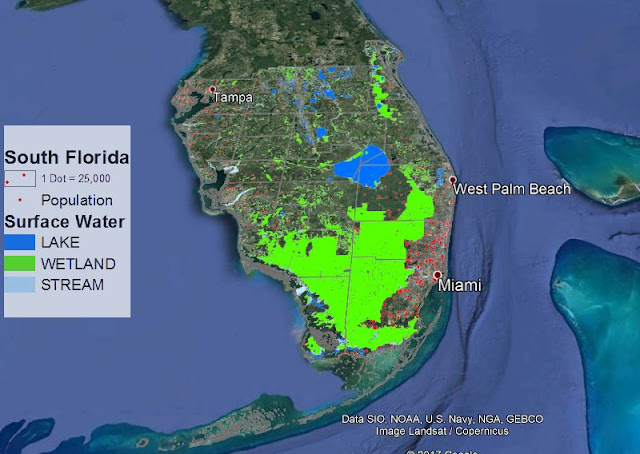3D Mapping
I started this week's work from the assigned ESRI Training Module on 3D Visualization Techniques Using ArcGIS software. The training was done on ESRI web portal. This training module introduced new terms in addition to new techniques such as:- Triangulated Irregular Networks (TINs),
- Terrain Datasets, and
- Multipatches.
The primary focus was working with 3D features, discrete geographic features such as buildings, rivers, and wells that can be found on or beneath a visible surface.
I also used ArcScene to display 2D features in a 3D rendering. In the first portion of the training learn how to navigate ArcScene, view 3D data and how to use the Attribute Table's Shape field to determine if the data is a 3D feature class. I then proceed to learned how to set Base Heights for raster data which are set to 0 by default and 3D views enhancement techniques.
 |
| Fig 1. Vertical Exaggeration of 3D layers |
In Fig.1, the visual effect of raster elevation data for the Twin Cities of Minnesota was changed by exaggerating the differences in elevation values. the measures values are not altered by executing the exaggeration technique but the appearance changes. Negative exaggeration has the effect of inverting the data's appearance. Changes in illumination values and background colors alters the appearance of data. Also changes to the appearance of sunlight's angle/altitude, emphasizes or reduces variations seen on the surface of the 3D rendition. It is also worthy of mention that background colors can make a 3D layer appear to float or provide geographic reference (sky, horizon, water body); a pop effect visually.
 |
| Fig.2. Extrusion of Buildings and Wells |
In Fig 2., above, I executed extrusion technique to extend features (building and wells) that are above and below the surface. Buildings were extruded above the surface using their Height value while Wells were extruded below the surface using their Depth value. The wells features appeared as flat points on the surface so an offset value was applied to raise them slightly above the surrounding surface. The aerial photo/picture layer in this Fig.2 was draped over the underlying elevation TIN layer, by setting the photo's base height to the elevation values of the TIN.
 |
| Fig.3. Extrusion of Land Parcel (showing cost/value of the buildings) |
 |
| Fig.4. Extruded Building in Boston viewed via Google Earth |
The last phase of this lab exercise was done in ArcMap and Google Earth. Using 3D Analyst tool (Create Random Points) I created Sample Points for 343 buildings in Boston and with these points I performed calculations to determined the mean height for each building which are represented by the z-values. The z-values were used to extrude the buildings in Boston. I then proceed to exported the extruded buildings data in order to create a layer and then converted that layer to a KML file. Finally, the create/exported KML file was opened in Google Earth as seen in Fig. 4 above.
The extruding buildings such as in the Boston buildings in Fig.4 enables viewers to visually focus on a specific area and view the buildings from different perspectives - above, street level, from different directions - building heights can be compared with relative ease.
Here are other map features created during the course of this lab for your view pleasure.
 |
| Fig.5. Elevation Layer draped with Raster (done in ArcScene) |
 |
| Fig.6. 3D Layer Classified (done in ArcGlobe) |
In conclusion I think it is worthy of note to mention that 3D mapping applications can be used for areal simulation, urban planning, transportation network, real estate, and census to mention just a few. This a fun lab and the result both satisfying and rewarding (visually).








